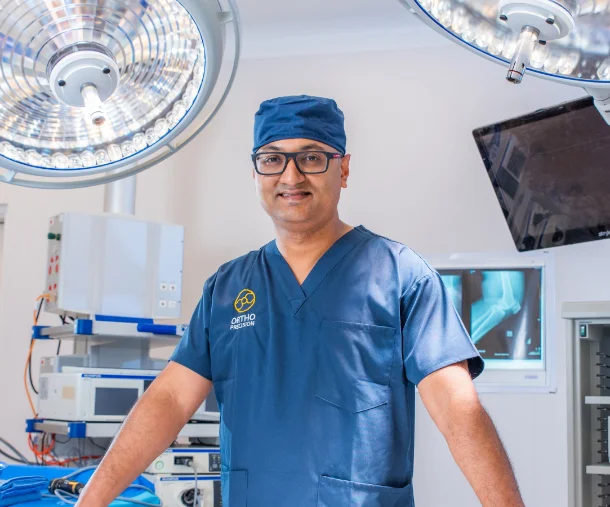Hip Fractures
Hip fractures are serious injuries involving a break in the upper portion of the femur (thighbone). These fractures can significantly impact mobility and quality of life, especially in older adults. Immediate medical attention and appropriate treatment are essential to ensure optimal recovery and prevent complications.
Dr Yas Edirisinghe is an Australian-trained orthopaedic surgeon with key expertise in diagnosing and treating hip conditions and fractures.
Types of Hip Fractures
There are three main types of hip fractures that are determined based on which part of the hip joint is fractured.
- Femoral Neck Fractures: These occur just below the ball of the hip joint. They can disrupt the blood supply to the femoral head, leading to complications like avascular necrosis (bone tissue death from lack of blood supply).
- Intertrochanteric Fractures: These fractures occur between the neck of the femur and the lesser trochanter, a bony prominence further down the femur. They generally have a better prognosis than femoral neck fractures due to a more robust blood supply.
- Subtrochanteric Fractures: These occur below the lesser trochanter, in the shaft of the femur. They can be more complex to treat due to the high force required to break this part of the bone.
Causes of Hip Fractures
Hip fractures can result from various causes, including:
- Falls are the most common cause, particularly in older adults with osteoporosis.
- High-impact accidents such as car crashes or significant sports injuries.
- Conditions like osteoporosis or bone cancer can weaken bones, making them more susceptible to fractures.
- Reduced bone density and muscle strength, along with balance issues, increase the risk of falls and fractures in the elderly.
Symptoms of Hip Fractures
Hip fracture symptoms include:
- Severe pain in the hip or groin area
- Inability to put weight on the affected leg
- Swelling and bruising around the hip
- Shortening of the affected leg
- Outward turning of the leg on the injured side
- Difficulty or inability to move after a fall.
Diagnosing Hip Fractures
The diagnostic process for hip fractures begins with a thorough physical examination to evaluate symptoms such as pain, swelling, deformity, and range of motion. X-rays are then utilised to obtain detailed images of the bones, helping with precise identification of the type and extent of the fracture. In cases where further clarity is needed, CT scans provide a more detailed view, particularly useful for complex fractures and aiding in surgical planning. Additionally, MRI scans may be employed to assess soft tissue damage, ensuring a thorough evaluation of the injury and guiding personalised treatment strategies.
Treatment for Hip Fractures
Treatment for hip fractures depends on the type, location, and severity of the fracture, as well as the patient’s overall health and activity level.
Non-Surgical Treatment for Hip Fractures
This approach typically involves pain management, limited weight-bearing, and physical therapy. It is only recommended in rare cases where the fracture is very stable or if the patient has significant health risks that make surgery unsafe.
Surgical Treatment for Hi Fractures
Most hip fractures require surgical intervention to ensure proper healing and restore mobility. Dr Yas Edirisinghe utilises 3D modelling technology for treating hip fractures with hip replacement surgery.
Surgical options include:
- Internal Fixation: Using screws, plates, or rods to stabilise the fracture.
- Hip Pinning: Inserting metal screws to hold the bone fragments together.
- Partial Hip Replacement: Replacing the broken part of the femur with a prosthesis.
- Total Hip Replacement: Replacing both the femoral head and the socket with artificial components, typically used for more severe fractures or when arthritis is also present.
Rehabilitation for Hip Fractures
Post-surgery rehabilitation is crucial for recovery. Physical therapy helps restore strength, mobility, and function. Dr Edirisinghe will develop a personalised rehabilitation plan tailored to each patient’s specific needs to ensure the best possible recovery.
At Ortho Precision, we are dedicated to providing comprehensive care for hip fractures. Dr Yas Edirisinghe uses the latest techniques and technologies to ensure optimal outcomes for his patients. If you suspect a hip fracture or have experienced a hip injury, contact us today to schedule a consultation and take the first step toward your recovery.

Advanced, patient-centred technology for better outcomes.
Contact us via the contact page or chatbot available across our website and Dr Yas will respond promptly.
